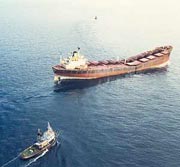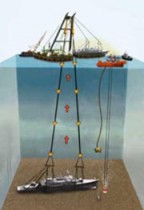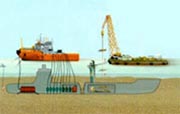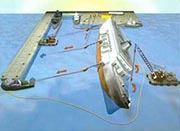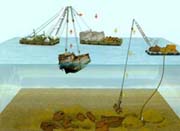Operations List
The 17.130 dwt General Cargo Vessel "CLIO" grounded at Bandar Khomeini in early December. The ship was carrying steel products and general cargo. TSAVLIRIS was awarded an LOF-2000 and tried to refloat the ship using local tugs an a high tide; when this failed, a decision was taken to lighten the vessel by about 2.500 tonnes before the second and successful attempt was made.
The 17.500 dwt cargo ship "ANASTASIA", laden with 14000 tons of sugar in bags, was en route from Santos Brazl to Lagos, Nigeria when she lost her power in South Atlantic. TSAVLIRIS – operated tug "LEOPARD" was immediately dispatched to assist the casualty and towed her to Takoradi, Ghana.
The 3.200 dwt cargo ship "CORVO", loaded with containers, ran aground at Azores. Engaged under a LOF agreement with Scopic clause, TSAVLIRIS dispatched the 40.000 hp "FOTIY KRYLOV". The vessel was wrecked.
The 52.500 dwt cargo ship "JOHN R", in ballast, grounded off Tromsoe, Norway. A LOF with Scopic clause was invoked and 3 subcontracted tugs were dispatched. The vessel was wrecked.
The 7.100 dwt cargo ship "COMPASS RAY", loaded with 300 containers, was immobilized off Western India. Under a LOF agreement, TSAVLIRIS sent off 2 subcontracted tugs. After supplying the vessel with electricity, she was towed to Colombo.
One of the most delicate operations handled by TSAVLIRIS was the salvage of the stricken 140,000 dwt ore/oil carrier "LASSIA" and her subsequent tow from Taranto to Turkey. The huge vessel had sagged and sunk amidships while discharging cargo ,blocking the bulk terminal in the Italian port. After 250 tonnes of bunkers have been removed from the vessel , the 41,000 tonnes of iron ore still on board was discharged in a strictly controlled sequence calculated through a damaged ship computer programme by the Group's own consultants and evaluated by the ABS rapid response centre in Huston . Meanwhile, the tugs "MEGAS ALEXANDROS" and "ATLAS" fought and restricted oil pollution from the vessel's ruptured pipes.
The 17.000 dwt motor vessel "TAI AN CHENG",loaded with cargo steel products grounded off Piraeus. TSAVLIRIS salvage tug "MEGAS ALEXANDROS" attended during refloating.
PRINCIPAL DATA
Ship raised:450 tonnes (lightweight)
Location:Eastern Aegean Sea
Specialized equipment and delicate calculations were called for in recovering the Anthipoploiarchos "KOSTAKOS". Her fragile hull almost severed in two at the point of collision, the naval missile boat was lying 160 metres down on the sea floor.
To recover four bodies as well as her valuable electronics and missiles, she had to be lifted intact. It was the first time that a ship was to be raised whole by mechanical means from such a depth.
Assets used included a saturated diving station vessel with deep-diving bell and dynamic positioning system, a sheer-leg crane with 1,000t lifting capacity and a barge adapted to hold the "KOSTAKOS". Helpfully, we were able to pre-test our special lifting apparatus, later colour-coded for connection underwater, on an identical military vessel.
We monitored the divers via a submersible robot camera as they surveyed the wreck-site and recovered a missing Penguin missile. They then moved on to dredging under the hull and rigging the steel slings. These were linked to the crane's hooks by sets of secondary tackle. Gently, the vessel was raised in stages corresponding to the height of the crane's A-frame, with an intermediary sling being discarded after each leg.
When the warship broke surface on 15 March 1997, satisfaction with our technical achievement was tampered by awareness of the remains of the four seamen still inside.
KEY ASPECTS:
- Critical stress analysis.
- Design of custom-manufactured lifting apparatus, wires, shackles, steel-pads to prevent slippage and cushion stress, etc.
- Assembly of task force of specialised salvage assets and 170 personnel; bad weather countermeasures .
- Safety monitoring of saturated diving operation and handling of munitions.
- Preservation of electronics and weapon systems.
PRINCIPAL DATA
Cargo removed:5.748 tonnes
Location:Hugli River, India
'Black water' diving was among many hazards TSAVLIRIS overcame in the "GREEN OPAL" project, which took us to India's Hugli River where the cargo ship had sunk. Once our salvage tug, floating crane barge and an array of other equipment was on-site, the first priority was to construct a secure mooring and properly illuminate the project for safety.
Since most of the wreck's bottom plating was badly fractured and she was virtually severed, the project required removing the cargo of nearly 6,000 tons of steel billets and wire coils. Our divers contended with zero visibility, raging currents and hard packed mud clogging the holds - but altogether they retrieved 3,900 separate pieces of cargo with the aid of a powerful underwater magnet and a vast range of purpose-made equipment.
Then came the most critical phase, which was to raise the wreck in two sections after parting them along the main existing fracture. Chain-cutting was performed to part the fore and aft sections, and a large number of 'sea camels' and 'baloons' was mobilised from Europe and China. These would be attached to the hull to provide sufficient buoyancy for the sections to rise from the bottom, so they could be towed to a nearby site for scrapping. However, after the completion of the cargo removal phase, the Club decided to cease the operation.
KEY ASPECTS:
- Deployment of a full anti-pollution system and cargo recovery equipment including magnet, mobile lifters, cranes and barges.
- On-site manufacture of a diving station and fabrication of a diving trunk to guide divers into the holds of the wreck, saving time required to deliver the nearest equivalent system.
- Safety management of a hazardous 'black water' diving opration.
- Disease prevention and medical support in an inhospitable environment.
- Deployment of 'sea camels' and buoyancy 'ballons'.
PRINCIPAL DATA
Ship raised: 7,300 tonnes (gross)
Location: Paros island, Greece
Speed was critical in removing this large ro-ro ferry before the peak summer tourist season arrived. After an unusual accident, the Poseidon Express had rolled onto her side in up to 22 metres of water and was partly blocking the port of one of Greece's favourite holiday islands.
Tsavliris technicians proposed an innovative solution to save time and cost. The ferry was to be rolled upright using a combination of her own positive stability and brute strength. In the lengthiest stage of the project, divers laboured to seal all openings in the vessel before pumping out the sea water. Constructing a new bulkhead in the garage to make the space watertight helped us stay on schedule.
As the hull regained boyancy, a system of pulleys and blocks, VLCC anchors, tractors, tugs and a floating crane assisted in wrenching the ferry upright. According to the P&I insurers, the 49 days taken to refloat the vessel was faster than forecast by any other major salvor which competed for the project.
KEY ASPECTS:
- Identifying and tank-testing of a novel new method of righting a capsized ro-ro ferry
- Fast mobilisation of locally available equipment to reduce time and cost.
- Avoidance of methods using a giant crane and winch platform which would have closed the port.
- Management of a salvage team of 80 plus 30 divers on a 24 hour basis.
- Additional tug and engineering services to maximise usage of Paros Port while the operation was in progress.
PRINCIPAL DATA
Ship raised: 1,800 tonnes (deadweight)
Cargo removed: 2.650 tonnes
Location: Lavezzi island off Corsica, France
Uniquely laborious, the Fenes project took four months, interrupted by a break for winter weather, which at one point required our salvage crew to be evacuated from the site by helicopter.
Run aground on the rocky Corsican coast, the freighter disintegrated under the pounding of waves and spilled her entire wheat cargo as she sank. As the incident occured in a protected marine park, local officials wanted an exceptionally thorough clean-up, which is exactly what we provided. We used an underwater vacuum pump to suck up the wheat, which had turned toxic on contact with salt water, from the seabed. Personnel wore masks to protect themselves from the sulphide gases as the cargo was separated from the water and loaded onto a barge for dumping far out to sea.
The vessel herself was in smithereens. After the floating crane had recovered most of the debris, a larger sheerleg crane was brough in to lift the 400t. accomodation and engine block. By the end, 700 separate pieces of the Fenes were raised from the seabed and disposed of.
KEY ASPECTS:
- Adjustment of operational goals after the vessel's disintegration in ferocious weather .
- Marshalling a team of 75 specialist personnel and divers / equipment including three salvage tugs, a crane barge and a sheerleg crane of 1,000t capacity.
- Handling of a toxic cargo.
- Coordination of clean-up with coast guard and environmental officials.

